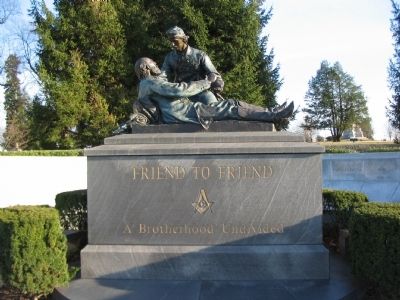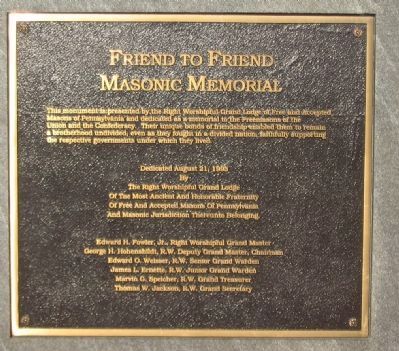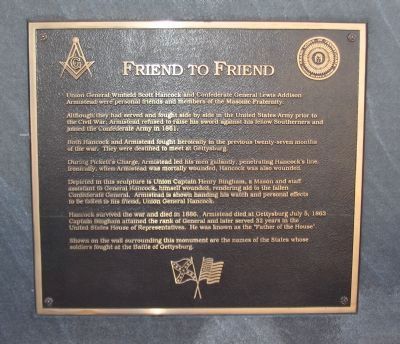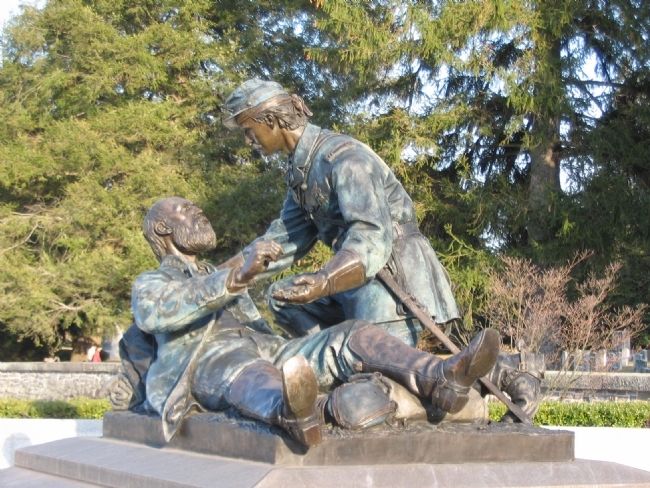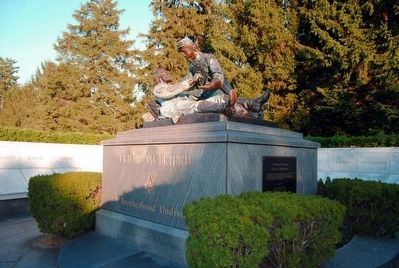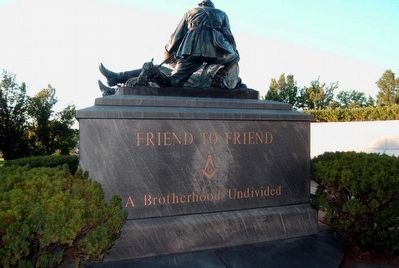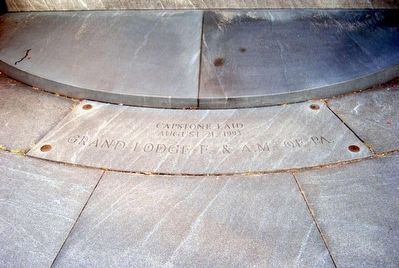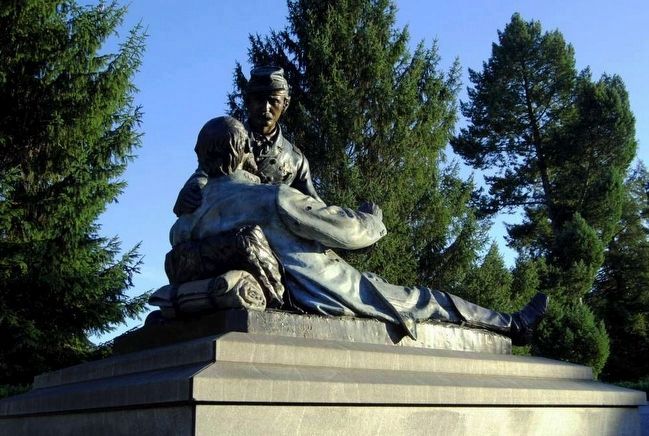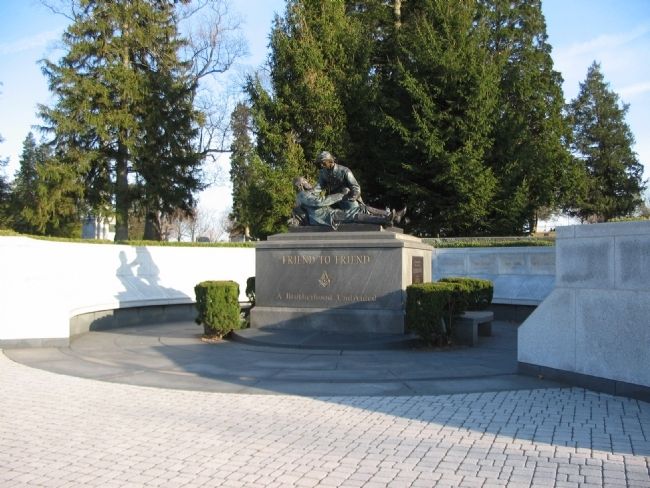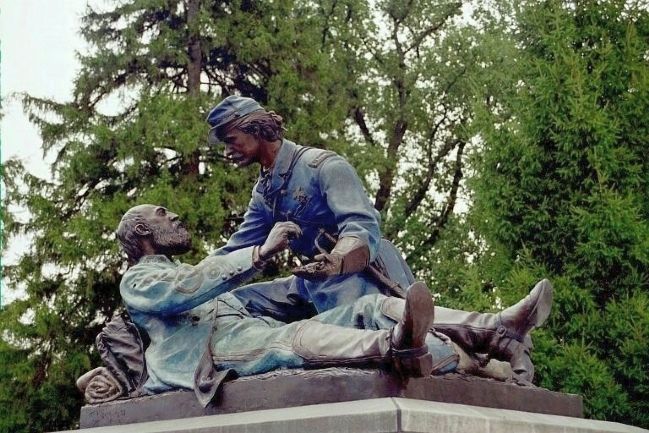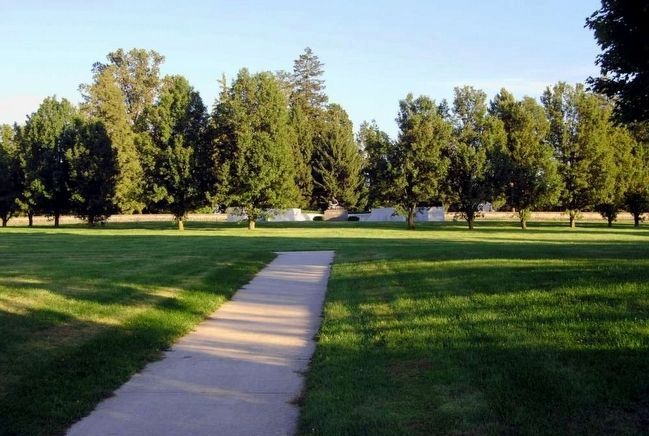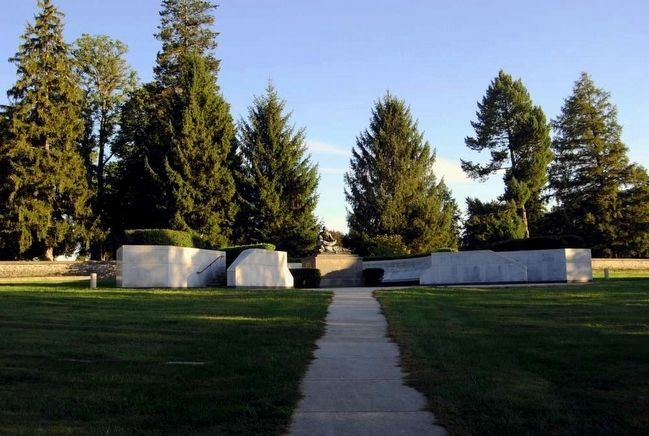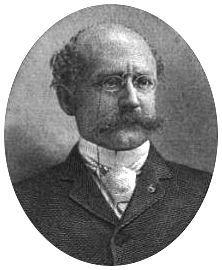Gettysburg in Adams County, Pennsylvania — The American Northeast (Mid-Atlantic)
Friend to Friend Masonic Memorial
Inscription.
(Front and Back):
A Brotherhood Undivided
(Left):
Masonic Memorial
This monument is presented by the Right Worshipful Grand Lodge of Free and Accepted Masons of Pennsylvania and dedicated as a memorial to the Freemasons of the Union and Confederacy. Their unique bonds of friendship enabled them to remain a brotherhood undivided, even as they fought in a divided nation, faithfully supporting the respective governments under which they lived.
By
The right Worshipful Grand Lodge
Of The Most Ancient And Honorable Fraternity
Of Free And Accepted Masons of Pennsylvania
And Masonic Jursidiction Thereunto Belonging.
Edward H. Fowler, Jr., Right Worshipful Grand Master
George H. Hohenshildt, R.W. Deputy Grand Master, Chairman
Edward O. Weisser, R.W. Senior Grand Warden
James L. Ernette, R.W. Junior Grand Warden
Marvin G. Speicher, R.W. Grand Treasurer
Thomas W. Jackson, R.W. Grand Secretary
(Right):
Union General Winfield Scott Hancock and Confederate General Lewis Addison Armistead were personal friends and members of the Masonic Fraternity.
Although they had served and fought side by side in the United States Army prior to the Civil War, Armistead refused to raise his sword against his fellow Southerners and joined the Confederate Army in 1861.
Both Hancock and Armistead fought heroically in the previous twenty-seven months of the war. They were destined to meet at Gettysburg.
During Pickett's Charge, Armistead led his men gallantly, penetrating Hancock's line. Ironically, when Armistead was mortally wounded, Hancock was also wounded.
Depicted in this sculpture is Union Captain Henry Bingham, a Mason and staff assistant to General Hancock, himself wounded, rendering aid to the fallen Confederate General. Armistead is shown handing his watch and personal effects to be taken to his friend, Union General Hancock.
Hancock survived the war and died in 1886. Armistead died at Gettysburg July 3, 1863. Captain Bingham attained the rank of General and later served 32 yeas in the United States House of Representatives. He was known as the "Father of the House".
Shown on the wall surrounding this monument are the names of the States whose soldiers fought at the Battle of Gettysburg.
Erected 1993 by The Right Worshipful Grand Lodge of Free and Accepted Masons of Pennsylvania.
Topics. This historical marker and memorial is listed in these topic lists: Fraternal or Sororal Organizations • War, US Civil. A significant historical date for this entry is July 3, 1863.
Location. 39° 49.258′ N, 77° 13.906′ W. Marker is in Gettysburg, Pennsylvania, in Adams County. Marker can be reached from the intersection of Steinwehr Avenue (State Highway 134) and Washington Street, on the right when traveling north. Located in the Gettysburg National Cemetery Annex. Touch for map. Marker is in this post office area: Gettysburg PA 17325, United States of America. Touch for directions.
Other nearby markers. At least 10 other markers are within walking distance of this marker. Gettysburg (about 300 feet away, measured in a direct line); New York State Memorial (about 300 feet away); 73rd Ohio Infantry (about 300 feet away); Freemasonry at Gettysburg (about 400 feet away); 55th Ohio Infantry (about 400 feet away); Bvt. Maj. Gen. Charles H.T. Collis Memorial (about 400 feet away); 75th Pennsylvania Volunteers (about 400 feet away); Major General John Reynolds (about 400 feet away); A Few Appropriate Remarks (about 500 feet away); Soldier’s National Monument (about 500 feet away). Touch for a list and map of all markers in Gettysburg.
Also see . . .
1. Winfield Scott Hancock. Winfield Scott Hancock (February 14, 1824 – February 9, 1886) was a career U.S. Army officer and the Democratic nominee for President of the United States in 1880. He served with distinction in the Army for four decades, including service in the Mexican-American War and as a Union general in the American Civil War. (Submitted on November 26, 2015, by Brian Scott of Anderson, South Carolina.)
2. Lewis Armistead. Lewis Addison Armistead (February 18, 1817 – July 5, 1863) was a career United States Army officer who became a brigadier general in the Confederate States Army during the American Civil War. On July 3, 1863, as part of Pickett's Charge during the Battle of Gettysburg, Armistead led his brigade to the farthest point reached by Confederate forces during the charge, a point now referred to as the high-water mark of the Confederacy. However, he and his men were overwhelmed, and he was wounded and captured by Union troops; he died in a field hospital two days later. (Submitted on November 26, 2015, by Brian Scott of Anderson, South Carolina.)
3. Henry H. Bingham. Henry Harrison Bingham (December 4, 1841 – March 22, 1912) was a Union Army officer in the American Civil War, who received the United States Military's highest award for valor, the Medal of Honor, for his actions at the Battle of the Wilderness. (Submitted on November 26, 2015, by Brian Scott of Anderson, South Carolina.)
4. Pickett's Charge. Pickett's Charge was an infantry assault ordered by Confederate Gen. Robert E. Lee against Maj. Gen. George G. Meade's Union positions on Cemetery Ridge on July 3, 1863, the last day of the Battle of Gettysburg in the state of Pennsylvania during the American Civil War. (Submitted on November 26, 2015, by Brian Scott of Anderson, South Carolina.)
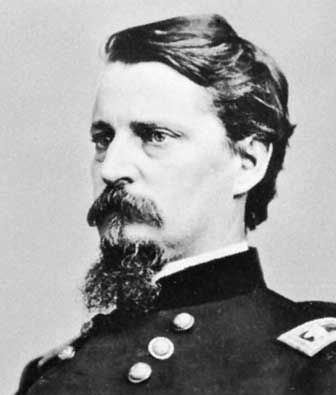
Photographed By Brian Scott
13. Major General Winfield Scott Hancock (1824-1886)
He was noted in particular for his personal leadership at the Battle of Gettysburg in 1863. One military historian wrote, "No other Union general at Gettysburg dominated men by the sheer force of their presence more completely than Hancock." As another wrote, "his tactical skill had won him the quick admiration of adversaries who had come to know him as the 'Thunderbolt of the Army of the Potomac'."
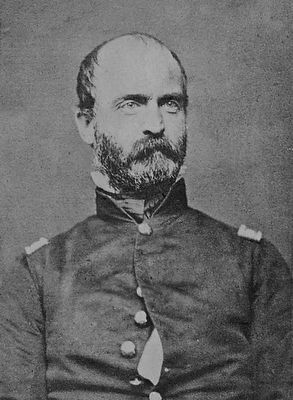
Photographed By Brian Scott
14. Brig. General Lewis Addison Armistead (1817-1863)
Armistead's wounds were not believed to be mortal; he had been shot in the fleshy part of the arm and below the knee, and according to the surgeon who tended him, none of the wounds caused bone, artery, or nerve damage. He was then taken to a Union field hospital at the George Spangler Farm where he died two days later.
Credits. This page was last revised on June 16, 2016. It was originally submitted on March 9, 2009, by Craig Swain of Leesburg, Virginia. This page has been viewed 1,568 times since then and 29 times this year. Photos: 1, 2, 3, 4. submitted on March 9, 2009, by Craig Swain of Leesburg, Virginia. 5, 6, 7, 8. submitted on November 26, 2015, by Brian Scott of Anderson, South Carolina. 9. submitted on March 9, 2009, by Craig Swain of Leesburg, Virginia. 10. submitted on July 8, 2013, by Mike Stroud of Bluffton, South Carolina. 11, 12, 13, 14, 15. submitted on November 26, 2015, by Brian Scott of Anderson, South Carolina.
